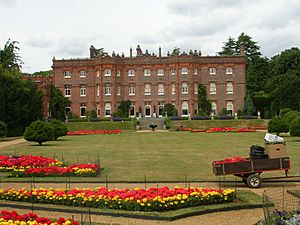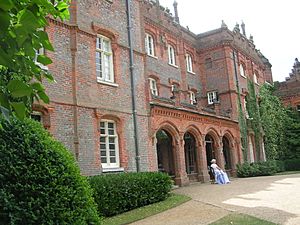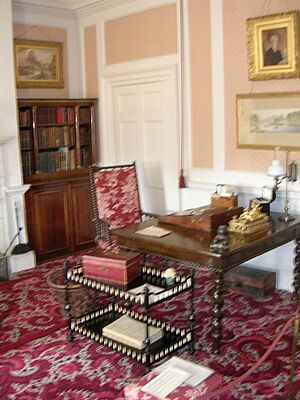Hughenden Manor facts for kids
Quick facts for kids Hughenden Manor |
|
|---|---|
 |
|
| Type | House |
| Location | High Wycombe, Buckinghamshire |
| Built | 18th and 19th centuries |
| Architect | Edward Buckton Lamb |
| Architectural style(s) | Jacobethan |
| Owner | National Trust |
|
Listed Building – Grade I
|
|
| Official name: Hughenden Manor | |
| Designated | 21 June 1955 |
| Reference no. | 1125785 |
|
Listed Building – Grade II
|
|
| Official name: Stable Block and Attached Garden Walls at Hughenden Manor | |
| Designated | 4 July 1985 |
| Reference no. | 1332071 |
| Official name: Hughenden Manor Park and Garden | |
| Designated | 30 July 1987 |
| Reference no. | 1000318 |
| Lua error in Module:Location_map at line 420: attempt to index field 'wikibase' (a nil value). | |
Hughenden Manor is a beautiful old house in Buckinghamshire, England. It was once the country home of a famous British Prime Minister named Benjamin Disraeli. Today, the National Trust looks after Hughenden Manor, and you can visit it to learn about its history. It's located on a hill near High Wycombe.
Contents
A Look at Hughenden Manor's History
Early Days of the Manor
The land where Hughenden Manor stands was first written about in 1086. It was part of Queen Edith's lands. Over many centuries, the ownership of the land changed hands several times. In 1539, the Crown gave the manor to Sir Robert Dormer. It stayed in his family for a long time.
Benjamin Disraeli's Home
In 1847, Isaac D'Israeli, the father of Benjamin Disraeli, bought Hughenden Manor. Benjamin Disraeli later became the Prime Minister of the United Kingdom. He took ownership of the manor in 1848 after his father passed away. Disraeli and his wife, Mary Anne, loved Hughenden. They spent a lot of time there, moving between the manor and their homes in London.
Mary Anne Disraeli passed away in 1872, and Benjamin Disraeli passed away in 1881. Both were buried in a churchyard near the house. Queen Victoria herself put up a special memorial for Disraeli in the church. This was the only time a British monarch ever put up a memorial for someone who wasn't royalty.
Hughenden After Disraeli
Benjamin Disraeli did not have any children. He left Hughenden Manor to his nephew, Coningsby Disraeli. Coningsby was only 14 years old at the time. So, the house was rented out until he was old enough to take over in 1888.
When Coningsby passed away in 1936, his widow left Hughenden. The next year, Disraeli's niece sold the house to W H Abbey. He then gave the house and its contents to the Disraelian Society.
Hughenden During World War II
During the Second World War, Hughenden Manor played a secret role. The basement of the house was used as a hidden intelligence base. Its code name was "Hillside." Staff from the UK Air Ministry worked there. They looked at aerial photographs of Germany. They also created maps for important bombing missions. This included maps for the famous "Dambusters" raid.
Hughenden Today
In 1947, the Abbey family and the Disraelian Society gave Hughenden Manor to the National Trust. This means it is now protected and open for everyone to visit. In 1955, it was named a Grade I listed building. This is a special status for buildings that are very important. The gardens are also listed as important historic sites.
The house is decorated to look like it did when Disraeli lived there. You can see family portraits and Disraeli's own furniture. There is also a library with his novels and books he inherited from his father. One book was even written and signed by Queen Victoria!
The park and woodlands around the manor are very large. They cover almost 1,500 acres. The formal garden was designed by Mary Anne Disraeli. It has been brought back to how it looked when the Disraelis lived there. There is a long terrace at the back of the house with beautiful Florentine vases. A monument to Disraeli's father was built by Mary Anne in 1862. You can see it on a nearby hill from the house.
In May 2024, Hughenden Manor was featured on a BBC documentary series. The show was called Hidden Treasures of the National Trust.
Architecture and Design of Hughenden Manor
The main house you see today was built in the late 1700s. It was a simple building at first. But in 1862, the Disraelis had the house changed by an architect named Edward Buckton Lamb. Lamb was known for his unique and interesting designs.
Under Lamb's direction, the house was completely transformed. He made it look more dramatic. He used a mix of different styles, like a castle. He used exposed bricks and added stepped battlements with pointed towers. The windows on the top floor of the garden side of the house have unusual shapes.
The house has three floors. The main rooms are on the ground floor. Many of these rooms have large plate glass windows. These were a new invention in Victorian times. They offer great views of the Hughenden Valley.
The west wing of the house was built in 1910. This was long after Disraeli had passed away. His nephew, Coningsby Disraeli, owned the house at that time.
See also
 In Spanish: Hughenden Manor para niños
In Spanish: Hughenden Manor para niños



